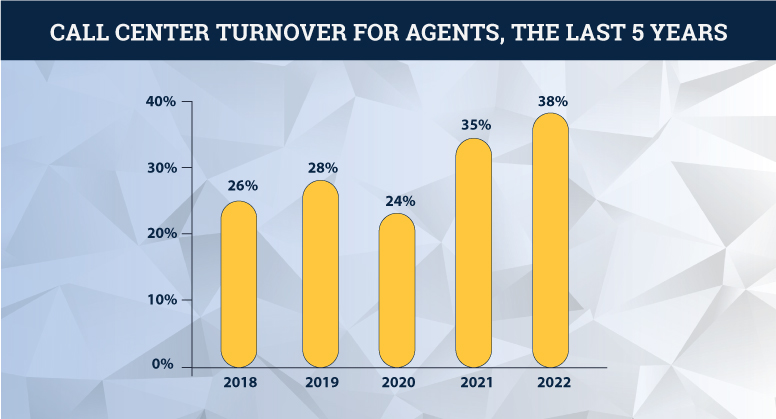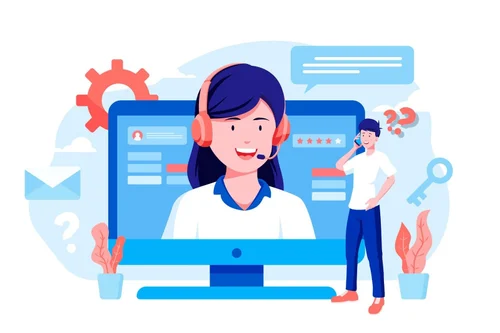Ever paused to think about who truly represents your brand?
When a customer dials your number, it's not the CEO or someone from the marketing team, but your call center agents who engage directly with your clientele. Being the brand's frontline warriors, they embody its voice, face, and at times, its essence.
That’s a big responsibility, right? Every interaction, every question answered, and every problem solved shapes your brand's image.An agent's failure can ripple into social media, reviews, and word-of-mouth, damaging your reputation.
By training agents effectively, you arm them with the requisite tools to navigate various scenarios, ensuring every call fortifies trust. This comprehensive guide explores the essence of call center training and how to adeptly implement it.
What Is Call Center Training?
Call center training empowers agents with the essential skills and knowledge to proficiently handle customer calls.
Topics covered include product awareness, communication strategies, problem-solving, and managing adversities, ensuring agents deliver consistent, sterling service synonymous with your brand's mission and culture.
Why Is Call Center Training Important?
Qualified agents have a tenfold impact on a company's success and its relationship with customers. Some benefits of training include:
1. Improves Agent Morale and Retention
Agents bear the brunt of customer frustrations, intricate queries, and the relentless pace of back-to-back calls. It's no wonder the turnover rate in the call center has been at 30 to 40% in the last two years.

High employee attrition disrupts operations and increases recruitment and training costs.
Every interaction is a "moment of truth" that makes or breaks a customer's perception. Agents learn to recognize and capitalize on these moments and turn potential issues into loyalty-building experiences.
Plus, no matter how great a product or service is, complaints are inevitable. Training prepares agents to address these complaints with soft skills like active listening and empathy and complaint-handling techniques.
2. Increases Customer Satisfaction
People love raving about positive experiences. In fact, research shows that 89% of customers are likely to make repeat purchases with companies that offer excellent customer service. These numbers highlight the incredible power of customer satisfaction in driving business growth and customer loyalty.
Well-trained agents address concerns, answer questions, and provide solutions faster. The result? Quicker resolution times and a more positive overall experience for the customer. It’s a cyclical effect that turns satisfied customers into brand ambassadors who spread positive word-of-mouth and influence others to choose your company.
3. Maintains and Enhances Brand Reputation
Every interaction between call center agents and customers reflects your brand.
Suppose a customer contacts a tech company's support line for assistance with a software issue. If the agent is unfamiliar with the product, takes too long to find information, or communicates poorly, the customer might leave the call thinking, "Is this the kind of quality and service I can expect from this company?"
On the flip side, an agent who navigates the problem, offers clear solutions, and displays in-depth product knowledge, paints the brand as competent, reliable, and worth the customer's trust.
7 Strategies for Better Call Center Training
By embracing the following strategies, you pave the way for creating a training program that enables your call center support agents to not only meet the expectations of customers but also go the extra mile in delivering stellar customer service, thus solidifying your brand's reputation in the competitive market landscape.
1. Make Use of Knowledge Management
Leveraging knowledge management for your call center is crucial for enhancing your support agents' training process. Effective knowledge management enables easy access to essential information that's important for the learning process of your customer service agents. This accessibility is key to amplifying the effectiveness of the training program, ensuring that agents can confidently address customer inquiries armed with the most current and relevant information. Such a system empowers agents to deliver precise and efficient responses, reflecting the high standards of customer service excellence your center aims to uphold.
Incorporating call center knowledge management software, particularly a comprehensive knowledge base, can significantly accelerate the training process. By providing this type of system, you offer your agents a structured approach to the training process. Furthermore, this approach promotes self-directed learning, allows agents to engage with the content at their own pace. This fosters a culture of continuous improvement and empowers agents to take ownership of their learning journey, which is essential for developing a competent and adaptable workforce.
2. Enable Feedback Mechanisms
A feedback loop is a system where you collect, analyze, and use inputs from both employees and customers to make improvements to service strategies and procedures.
Why does this matter?
- It creates a culture of continuous improvement, where agents understand their strengths and areas for growth.
- It aligns customer support efforts with customer expectations, needs, and frustrations and ensures your call center evolves with your audience's demands.
Here’s the goldmine: review call recordings.
This practice assesses agents' etiquette, efficiency, and effectiveness. Identifying strengths and weaknesses helps managers provide targeted coaching to improve individual agent performance and overall call center quality.
How do you formalize this process?
Through Q&A scorecards. Managers evaluate agents' calls against standardized criteria to ensure consistency and objectivity in feedback. Agents no longer need to wonder what's expected of them—they have clear benchmarks to meet and exceed.
Regular feedback from agents and customers turns your call center into a dynamic, adaptive force.
3. Provide Technical Onboarding
Technical onboarding introduces new agents to the tools they'll use daily. Think knowledge base solutions, CRM systems, ticketing platforms, and call routing software.
But how do you ensure a smooth onboarding? Start with a checklist:
- Do agents understand the basic functionalities of your technology stack such as your CRM, knowledge management platform, call center tools, etc.?
- Can they navigate the ticketing platform?
- Are they comfortable with call routing and handling multiple channels (e.g., chat, email, voice)?
- Do they know how to access and update customer information?
- Can they troubleshoot common technical issues or know the channels to report them?
- Have you introduced agents to all software integrations and plugins?
- Do they understand the protocols for data privacy and security measures?
- Are they familiar with the process for software updates or upgrades?
- Can they use internal communication tools for team collaboration?
- Do they know how to customize their dashboard or interface for optimal workflow?
- Can they handle potential software downtimes or outages?
- Have you trained agents on backup procedures and alternate systems in emergencies?
- Do they know where to access tutorial videos or user manuals for each software?
- Are they clear on escalation processes for tech-related concerns that exceed their expertise?
This way, you identify knowledge gaps and offer targeted training.
4. Introduce Role-Playing Exercises
Role-playing exercises can be a very useful training method when it comes to call center training, as these exercises allow you to replicate real-world customer interactions in a controlled, risk-free environment. They present agents with a spectrum of customer scenarios, mirroring the unpredictability inherent in customer service roles.
Through these simulated interactions, agents get to practice, make mistakes, receive feedback, and fine-tune their approach, all without the potential fallout of a real-world misstep. The experiential nature of role-playing fast-tracks the learning process, making it an invaluable asset in your training toolkit.
Imagine an agent confronted with an irate customer. In a real interaction, a misstep in communication or a delayed response could strain the customer relationship, possibly leading to a tarnished brand image. Role-playing serves as a rehearsal platform, offering a space for agents to navigate such challenging scenarios, receive constructive feedback, and build their confidence in handling similar situations proficiently.
Some example role-playing scenarios you might consider to offer a more rounded training experience for your agents:
- The Inquisitive Customer - Handling customers who have many questions regarding the product or service.
- The Hesitant Customer - Encouraging customers to make a decision when they are indecisive.
- The Tech-Challenged Customer - Assisting customers who struggle with technology.
- The Language Barrier Customer - Developing communication skills when language barriers exist.
- The Repeat Customer - Building rapport and recognizing returning customers to provide personalized service.
- The High Expectations Customer - Meeting and managing the expectations of customers who demand excellence.
- The Emergency Situation - Handling urgent or crisis situations calmly and effectively.
- The Upsell Scenario - Identifying opportunities to upsell or cross-sell products and services.
- The Privacy-Concerned Customer - Addressing concerns regarding data privacy and security.
- The Feedback Request - Encouraging customers to provide feedback or complete satisfaction surveys.
As you can see, roleplaying exercisies extend beyond managing difficult interactions. It’s a versatile tool that also simulates opportunities for upselling, addressing technical queries, and handling routine inquiries. Each of these scenarios imparts distinct lessons, helping agents hone their skills in managing a range of customer interactions - a critical factor in elevating customer satisfaction levels.
Here's how you can integrate role-playing exercises into your training sessions:
- Introduce the Issue: Initiate the session by gathering participants in a suitable training area. Introduce the topic for role-play, explaining its purpose and expected outcomes. Engage trainees in a preliminary discussion to set the stage for the exercise.
- Provide Details: Share background information about the scenario and the expected conduct during the role-play, ensuring a clear understanding and authenticity in enactment.
- Assign Roles: Introduce the characters involved in the scenario and delegate roles to the participants, making sure they fully understand their respective roles and tasks.
- Act out a Scenario: Allow participants to enact their roles, while others observe, advising them to escalate the situation gradually to practice diverse social skills.
- Discuss the Experience: After the role-play, engage all participants in a discussion, analyzing the approach, communication, and strategies employed, and reflecting on how these can be translated to real-world scenarios.
By following these steps, you create an interactive and constructive learning environment where agents can evolve and become the brand ambassadors your company needs. Through role-playing, you're not just teaching your agents the ropes of customer service, but also instilling a culture of continuous learning and improvement.
Moreover, the hands-on, experiential nature of role-playing exercises significantly enhances knowledge retention, enabling agents to recall and apply what they've learned effectively in real-world customer interactions.
5. Prioritize Emotional Intelligence Training
Emotional intelligence training teaches agents to recognize, understand, and manage their emotions while interacting with customers. It also helps them read and respond to others' emotions.
Why is this important? Simple: a high EQ (emotional quotient) leads to better communication, improved customer relations, and fewer misunderstandings.
So, how do you implement this?
- Awareness workshops: Hold sessions that help agents identify their emotional triggers and reactions.
- Active listening: Teach agents to listen without interrupting, focusing fully on the customer.
- Empathy drills: Role-play scenarios where agents put themselves in the customer's shoes.
- Feedback sessions: Regularly discuss emotional responses to certain calls, fostering a learning environment.
- Stress management: Offer techniques like deep breathing or short breaks to help agents stay calm.
- Mindfulness practices: Integrate mindfulness exercises or meditation breaks, aiding agents in staying present and centered during interactions.
6. Focus on Call Center Etiquette
A call center's etiquette is about being courteous and professional during customer interactions. Proper etiquette ensures clear communication, builds trust, and promotes a positive brand image.
Key etiquette areas to focus on:
- Greeting warmly: Always start with a friendly hello and introduce oneself.
- Active listening: Give customers the full attention they deserve without interrupting.
- Clear communication: Avoid jargon and use simple language.
- Polite tone: Always maintain a calm, respectful tone, even during challenging interactions.
- Holding procedures: Inform customers before putting them on hold and thank them for their patience.
- Closing gracefully: Ensure agents address the customer's concerns before ending the call.
- Personalization: Use the customer's name for a more personal touch.
- Respecting privacy: Ensure confidentiality and ask for personal or credit card information only when absolutely necessary.
- Timely follow-ups: If a solution requires more time, assure the customer and provide a clear timeframe for the next touchpoint.
- Admitting Mistakes: If there's an error on your end, admit it and work towards solving it.
7. Implement Gamification to Boost Performance Metrics
Incorporate gamification techniques to motivate agents and sharpen their skills.
Here's how it works: By setting up a system where achievements are rewarded—think points, badges, or even levels—agents see their progress in real time. This fosters a sense of accomplishment and friendly competition. This way, For instance, agents earn points for, suppose, reducing their average call resolution time or getting positive customer feedback.
Metrics to gamify include:
- Resolution time: Rewarding agents for quick, yet effective problem-solving.
- Customer satisfaction: Points for positive customer ratings.
- Call handling time: Incentives for maintaining comprehensive, yet concise calls.
- First call resolution: Bonuses for resolving issues on the first call, enhancing customer experience.
It encourages continuous improvement, personal growth, and engagement in daily tasks. Agents become more invested in their roles, striving not just to meet, but to exceed targets.
How to Ensure Ongoing Training Success
After setting up your call center training, the real work begins: ensuring its ongoing success. Adapt to new challenges, tech shifts, and business needs.
Here’s how:
- Conduct regular performance reviews of your customer service team: Make use of evaluation forms, one-to-one meetings, feedback, etc. and then analyze the results.
- Update training material: As products, services, or company policies change, update your training materials.
- Offer advanced training modules: After agents master the basics, offer advanced modules to keep them sharp.
-
Invest in tech: Use VR training simulations and AI-powered training bots to make training more fun.
Keep up with industry best practices: Stay in the loop with the latest training methodologies and best practices to keep your program top-tier.
Equip Agents with Essential Training Resources
The right call center agents are empathetic, patient, and master problem-solvers. But they also have the right resources available at their disposal.
What does that include? Technical onboarding tools, feedback systems, and, of course, a comprehensive knowledge base that ensures they're never left scratching their heads during a call.
Helpjuice's knowledge base platform streamlines access to vital information and cuts down the time spent searching for answers. Its intuitive interface and smart search capabilities mean agents get accurate solutions fast. Try it out today and make your team more proficient and customer-focused.


![7 Ways to Reduce Call Center Volume [2023]](https://static.helpjuice.com/helpjuice_production/uploads/upload/image/4752/3139829/1683914380553-Call%2BCenter%2BCalls.jpg)
